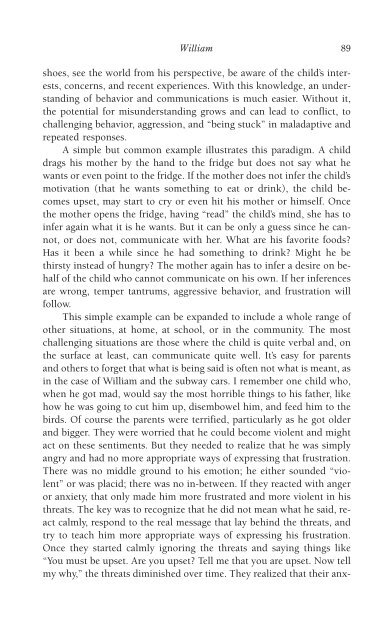978-1572305441
autism
autism
Create successful ePaper yourself
Turn your PDF publications into a flip-book with our unique Google optimized e-Paper software.
William 89<br />
shoes, see the world from his perspective, be aware of the child’s interests,<br />
concerns, and recent experiences. With this knowledge, an understanding<br />
of behavior and communications is much easier. Without it,<br />
the potential for misunderstanding grows and can lead to conflict, to<br />
challenging behavior, aggression, and “being stuck” in maladaptive and<br />
repeated responses.<br />
A simple but common example illustrates this paradigm. A child<br />
drags his mother by the hand to the fridge but does not say what he<br />
wants or even point to the fridge. If the mother does not infer the child’s<br />
motivation (that he wants something to eat or drink), the child becomes<br />
upset, may start to cry or even hit his mother or himself. Once<br />
the mother opens the fridge, having “read” the child’s mind, she has to<br />
infer again what it is he wants. But it can be only a guess since he cannot,<br />
or does not, communicate with her. What are his favorite foods?<br />
Has it been a while since he had something to drink? Might he be<br />
thirsty instead of hungry? The mother again has to infer a desire on behalf<br />
of the child who cannot communicate on his own. If her inferences<br />
are wrong, temper tantrums, aggressive behavior, and frustration will<br />
follow.<br />
This simple example can be expanded to include a whole range of<br />
other situations, at home, at school, or in the community. The most<br />
challenging situations are those where the child is quite verbal and, on<br />
the surface at least, can communicate quite well. It’s easy for parents<br />
and others to forget that what is being said is often not what is meant, as<br />
in the case of William and the subway cars. I remember one child who,<br />
when he got mad, would say the most horrible things to his father, like<br />
how he was going to cut him up, disembowel him, and feed him to the<br />
birds. Of course the parents were terrified, particularly as he got older<br />
and bigger. They were worried that he could become violent and might<br />
act on these sentiments. But they needed to realize that he was simply<br />
angry and had no more appropriate ways of expressing that frustration.<br />
There was no middle ground to his emotion; he either sounded “violent”<br />
or was placid; there was no in-between. If they reacted with anger<br />
or anxiety, that only made him more frustrated and more violent in his<br />
threats. The key was to recognize that he did not mean what he said, react<br />
calmly, respond to the real message that lay behind the threats, and<br />
try to teach him more appropriate ways of expressing his frustration.<br />
Once they started calmly ignoring the threats and saying things like<br />
“You must be upset. Are you upset? Tell me that you are upset. Now tell<br />
my why,” the threats diminished over time. They realized that their anx-



